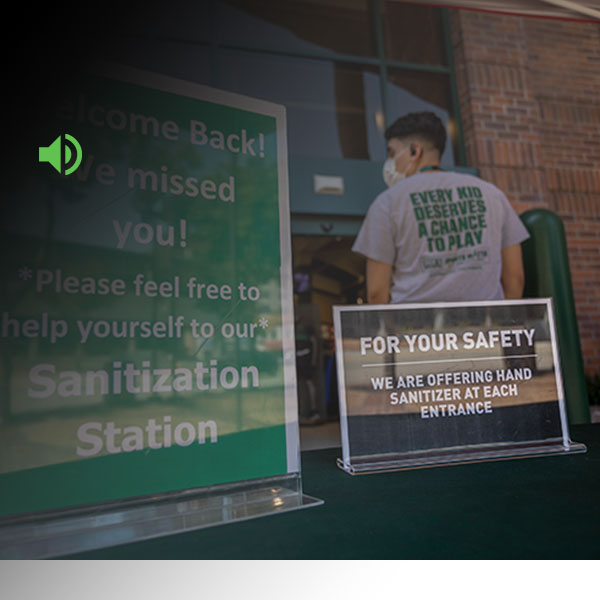Story Highlights
- About a third of parents prefer a remote learning option for their child
- School cleaning and required health screenings affect parents' attitudes
Editor's Note: The research below was conducted in partnership between Franklin Templeton and Gallup.
WASHINGTON, D.C. -- Almost half (45%) of U.S. parents report they are "very worried" that their children will contract COVID-19 at school or in childcare facilities. Twenty-seven percent report they are "somewhat worried," 13% are "not too worried" and 9% are "not at all worried."
| Parents with children aged 0-18 | |||||||||||||||||||||||||||||||||||||||||||||||||||||||||||||||||||||||||||||||||||||||||||||||||||
|---|---|---|---|---|---|---|---|---|---|---|---|---|---|---|---|---|---|---|---|---|---|---|---|---|---|---|---|---|---|---|---|---|---|---|---|---|---|---|---|---|---|---|---|---|---|---|---|---|---|---|---|---|---|---|---|---|---|---|---|---|---|---|---|---|---|---|---|---|---|---|---|---|---|---|---|---|---|---|---|---|---|---|---|---|---|---|---|---|---|---|---|---|---|---|---|---|---|---|---|
| % | |||||||||||||||||||||||||||||||||||||||||||||||||||||||||||||||||||||||||||||||||||||||||||||||||||
| Very worried | 45 | ||||||||||||||||||||||||||||||||||||||||||||||||||||||||||||||||||||||||||||||||||||||||||||||||||
| Somewhat worried | 27 | ||||||||||||||||||||||||||||||||||||||||||||||||||||||||||||||||||||||||||||||||||||||||||||||||||
| Not too worried | 13 | ||||||||||||||||||||||||||||||||||||||||||||||||||||||||||||||||||||||||||||||||||||||||||||||||||
| Not at all worried | 9 | ||||||||||||||||||||||||||||||||||||||||||||||||||||||||||||||||||||||||||||||||||||||||||||||||||
| FRANKLIN TEMPLETON-GALLUP ECONOMICS OF RECOVERY STUDY, SEPT. 4-13, 2020 | |||||||||||||||||||||||||||||||||||||||||||||||||||||||||||||||||||||||||||||||||||||||||||||||||||
These results are from the Franklin Templeton-Gallup Economics of Recovery From COVID-19 study, based on more than 5,000 web-based surveys conducted via an opt-in panel. The sample of U.S. adults was weighted to represent the entire U.S. adult population.
About Half of "Very Worried" Parents Prefer Remote Instruction
Parents whose child or children are enrolled in schooling (93% of all parents with children from birth to 18 years of age) were asked what type of schooling they currently want their child's school to offer. Most parents who have one or more children enrolled in school would prefer that their child's school have some level of in-person learning, either full time or part time, with some distance learning. However, about a third of parents would prefer that their child's school offer full-time remote learning, and that rate increases among those who are very worried their child will contract the virus.
When parents are asked which of a series of factors affect their attitudes toward in-person instruction, cleanliness and sanitation procedures, requirements of daily health screenings, effectiveness of remote learning and mask-wearing requirements are the most important.
| Major impact | Minor impact | No impact | |||||||||||||||||||||||||||||||||||||||||||||||||||||||||||||||||||||||||||||||||||||||||||||||||
|---|---|---|---|---|---|---|---|---|---|---|---|---|---|---|---|---|---|---|---|---|---|---|---|---|---|---|---|---|---|---|---|---|---|---|---|---|---|---|---|---|---|---|---|---|---|---|---|---|---|---|---|---|---|---|---|---|---|---|---|---|---|---|---|---|---|---|---|---|---|---|---|---|---|---|---|---|---|---|---|---|---|---|---|---|---|---|---|---|---|---|---|---|---|---|---|---|---|---|---|
| % | % | % | |||||||||||||||||||||||||||||||||||||||||||||||||||||||||||||||||||||||||||||||||||||||||||||||||
| Cleanliness and sanitation procedures of school | 51 | 33 | 16 | ||||||||||||||||||||||||||||||||||||||||||||||||||||||||||||||||||||||||||||||||||||||||||||||||
| Requirements for daily health screenings of students, teachers and staff | 47 | 34 | 18 | ||||||||||||||||||||||||||||||||||||||||||||||||||||||||||||||||||||||||||||||||||||||||||||||||
| Effectiveness of remote learning | 46 | 36 | 18 | ||||||||||||||||||||||||||||||||||||||||||||||||||||||||||||||||||||||||||||||||||||||||||||||||
| Requirements for students, teachers and staff to wear masks at school | 46 | 33 | 20 | ||||||||||||||||||||||||||||||||||||||||||||||||||||||||||||||||||||||||||||||||||||||||||||||||
| Class size | 44 | 32 | 24 | ||||||||||||||||||||||||||||||||||||||||||||||||||||||||||||||||||||||||||||||||||||||||||||||||
| Amount of outdoor recreation and activities | 38 | 40 | 22 | ||||||||||||||||||||||||||||||||||||||||||||||||||||||||||||||||||||||||||||||||||||||||||||||||
| Work requirements for your job | 37 | 32 | 31 | ||||||||||||||||||||||||||||||||||||||||||||||||||||||||||||||||||||||||||||||||||||||||||||||||
| Amount of outdoor instruction | 36 | 41 | 23 | ||||||||||||||||||||||||||||||||||||||||||||||||||||||||||||||||||||||||||||||||||||||||||||||||
| FRANKLIN TEMPLETON-GALLUP ECONOMICS OF RECOVERY STUDY, SEPT. 4-13, 2020 | |||||||||||||||||||||||||||||||||||||||||||||||||||||||||||||||||||||||||||||||||||||||||||||||||||
The implementation of safety steps has a greater impact on the feelings toward in-person schooling among those who are very worried about their children contracting COVID-19 at their school or childcare center. Two-thirds of parents who are very worried -- versus less than one-third who are not "very worried" -- say requirements for daily health screenings would have a major impact on their feelings. Parents who are very worried are also more likely than those who are not to say cleanliness and sanitation, class size and mask-wearing requirements would have a major impact on their feeling about in-person schooling for their child(ren).
| "Very worried" | Not "very worried" | ||||||||||||||||||||||||||||||||||||||||||||||||||||||||||||||||||||||||||||||||||||||||||||||||||
|---|---|---|---|---|---|---|---|---|---|---|---|---|---|---|---|---|---|---|---|---|---|---|---|---|---|---|---|---|---|---|---|---|---|---|---|---|---|---|---|---|---|---|---|---|---|---|---|---|---|---|---|---|---|---|---|---|---|---|---|---|---|---|---|---|---|---|---|---|---|---|---|---|---|---|---|---|---|---|---|---|---|---|---|---|---|---|---|---|---|---|---|---|---|---|---|---|---|---|---|
| % | % | ||||||||||||||||||||||||||||||||||||||||||||||||||||||||||||||||||||||||||||||||||||||||||||||||||
| Requirements for daily health screenings of students, teachers and staff | 66 | 31 | |||||||||||||||||||||||||||||||||||||||||||||||||||||||||||||||||||||||||||||||||||||||||||||||||
| Cleanliness and sanitation procedures of school | 63 | 40 | |||||||||||||||||||||||||||||||||||||||||||||||||||||||||||||||||||||||||||||||||||||||||||||||||
| Class size | 62 | 27 | |||||||||||||||||||||||||||||||||||||||||||||||||||||||||||||||||||||||||||||||||||||||||||||||||
| Effectiveness of remote learning | 61 | 33 | |||||||||||||||||||||||||||||||||||||||||||||||||||||||||||||||||||||||||||||||||||||||||||||||||
| Requirements for students, teachers and staff to wear masks at school | 60 | 34 | |||||||||||||||||||||||||||||||||||||||||||||||||||||||||||||||||||||||||||||||||||||||||||||||||
| Work requirements for your job | 54 | 22 | |||||||||||||||||||||||||||||||||||||||||||||||||||||||||||||||||||||||||||||||||||||||||||||||||
| Amount of outdoor recreation and activities | 53 | 25 | |||||||||||||||||||||||||||||||||||||||||||||||||||||||||||||||||||||||||||||||||||||||||||||||||
| Amount of outdoor instruction | 51 | 22 | |||||||||||||||||||||||||||||||||||||||||||||||||||||||||||||||||||||||||||||||||||||||||||||||||
| FRANKLIN TEMPLETON-GALLUP ECONOMICS OF RECOVERY STUDY, SEPT. 4-13, 2020 | |||||||||||||||||||||||||||||||||||||||||||||||||||||||||||||||||||||||||||||||||||||||||||||||||||
Summary
K-12 schools nationally are navigating and transitioning between in-person, remote and hybrid learning options as the COVID-19 virus continues to spread. As school systems struggle, so do parents who are juggling work and the reality of remote learning and the unpredictability of in-person school. Full economic recovery will remain out of reach until schools can safely instruct students in person, as parents have to be able to participate fully in the economy -- as consumers and as employees. The monitoring and supervision required for remote learning affect these parents' ability to leave the home and engage in a series of activities, as well as their productivity within their workplace, which has a significant and detrimental impact on employers.
Yet in-person instruction is unlikely to succeed if schools cannot implement required safety protocols that scientists report are necessary to slow the virus' spread. Such steps -- sanitation procedures, daily health screenings and social distancing -- are among the measures concerned parents most want to see in order to send their children back to school.
To receive ongoing updates on the project's findings, please sign up here. To read the project announcement press release, please visit this page.
If you are a member of the media who would like to learn more about the project's findings and release schedule, please reach out to Riley_Brands@gallup.com.




